Charles E W Bean, Diaries, AWM38 3DRL 606/274/1 - 1918 - 1941 - Part 6
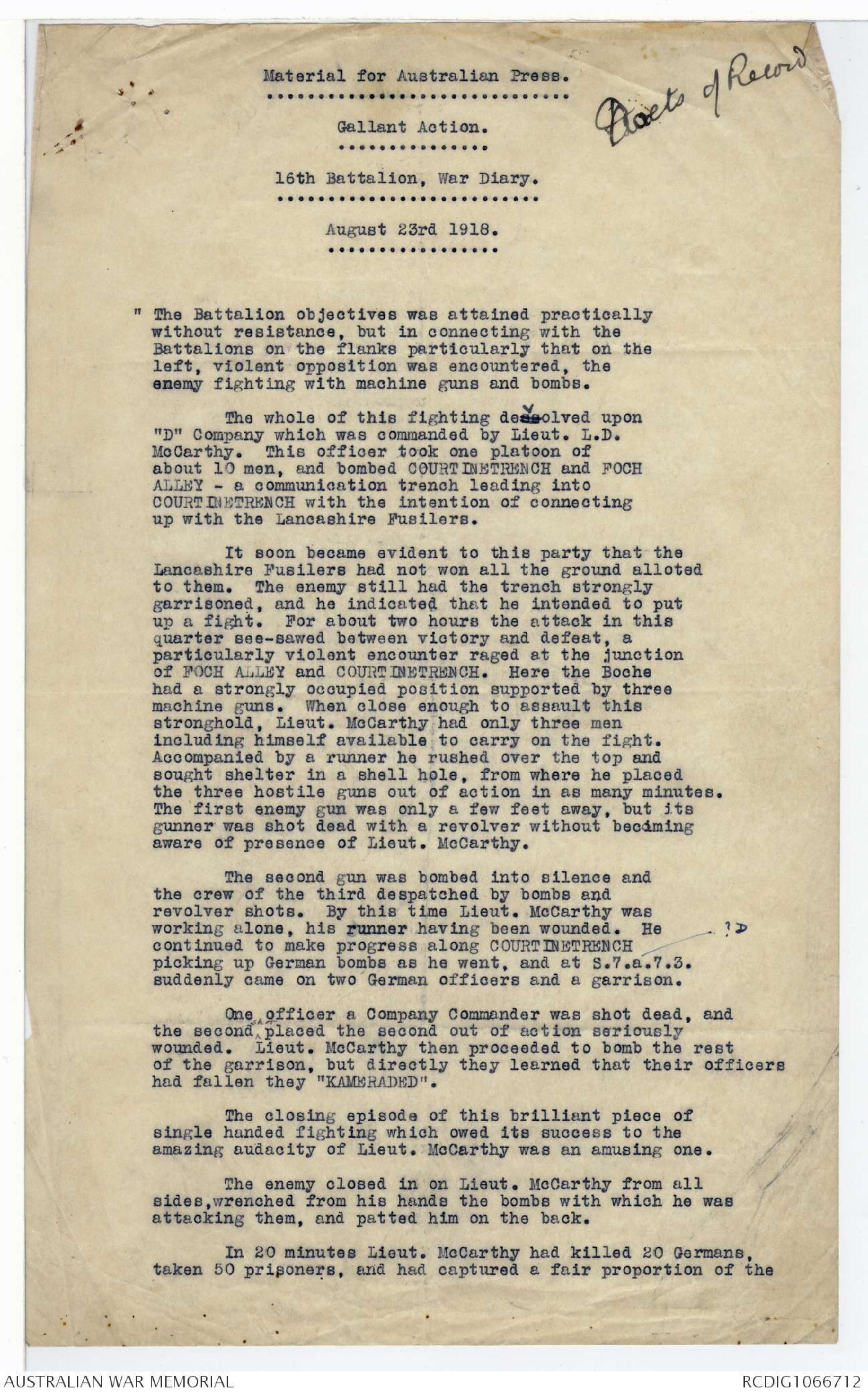
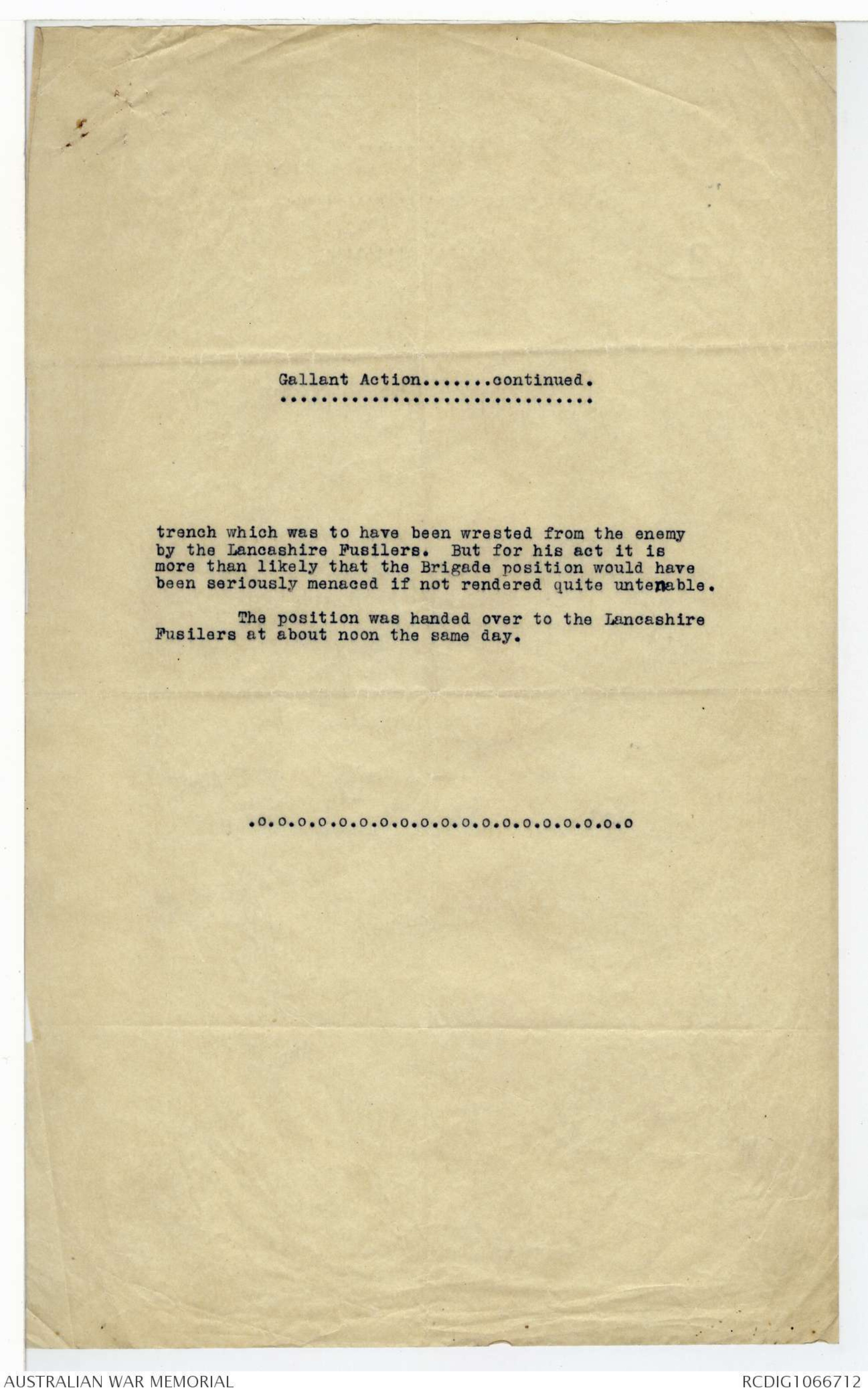

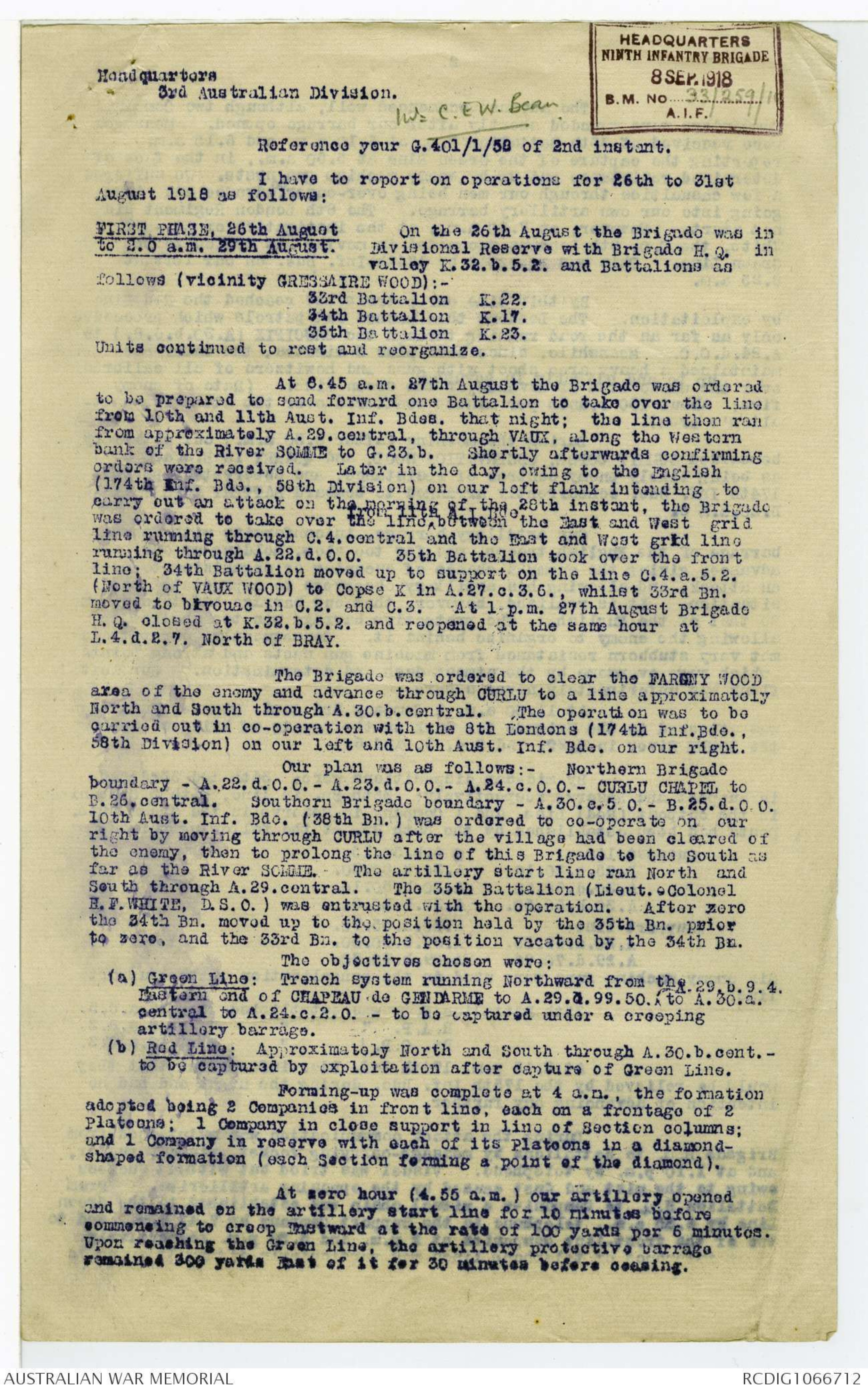
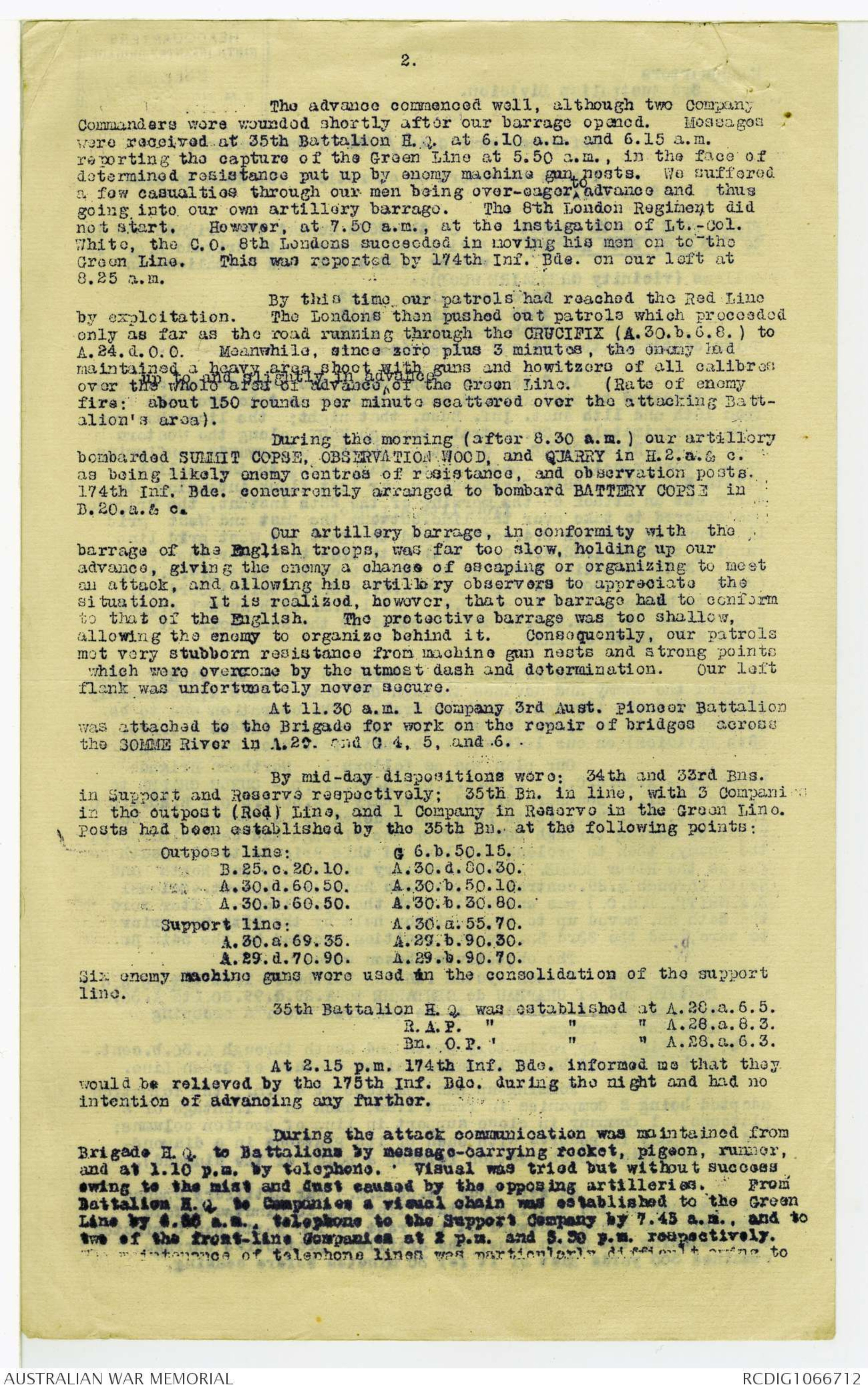
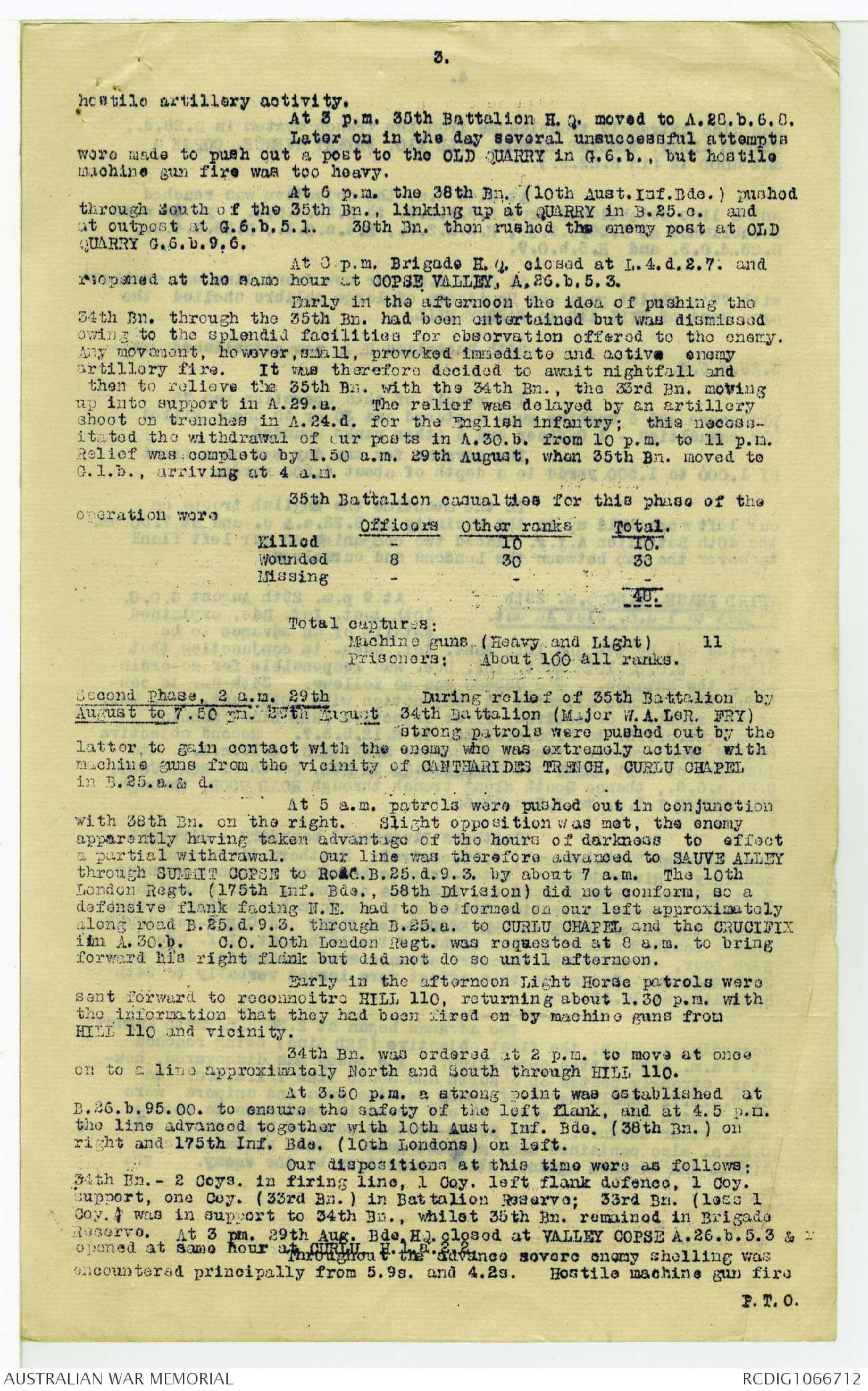
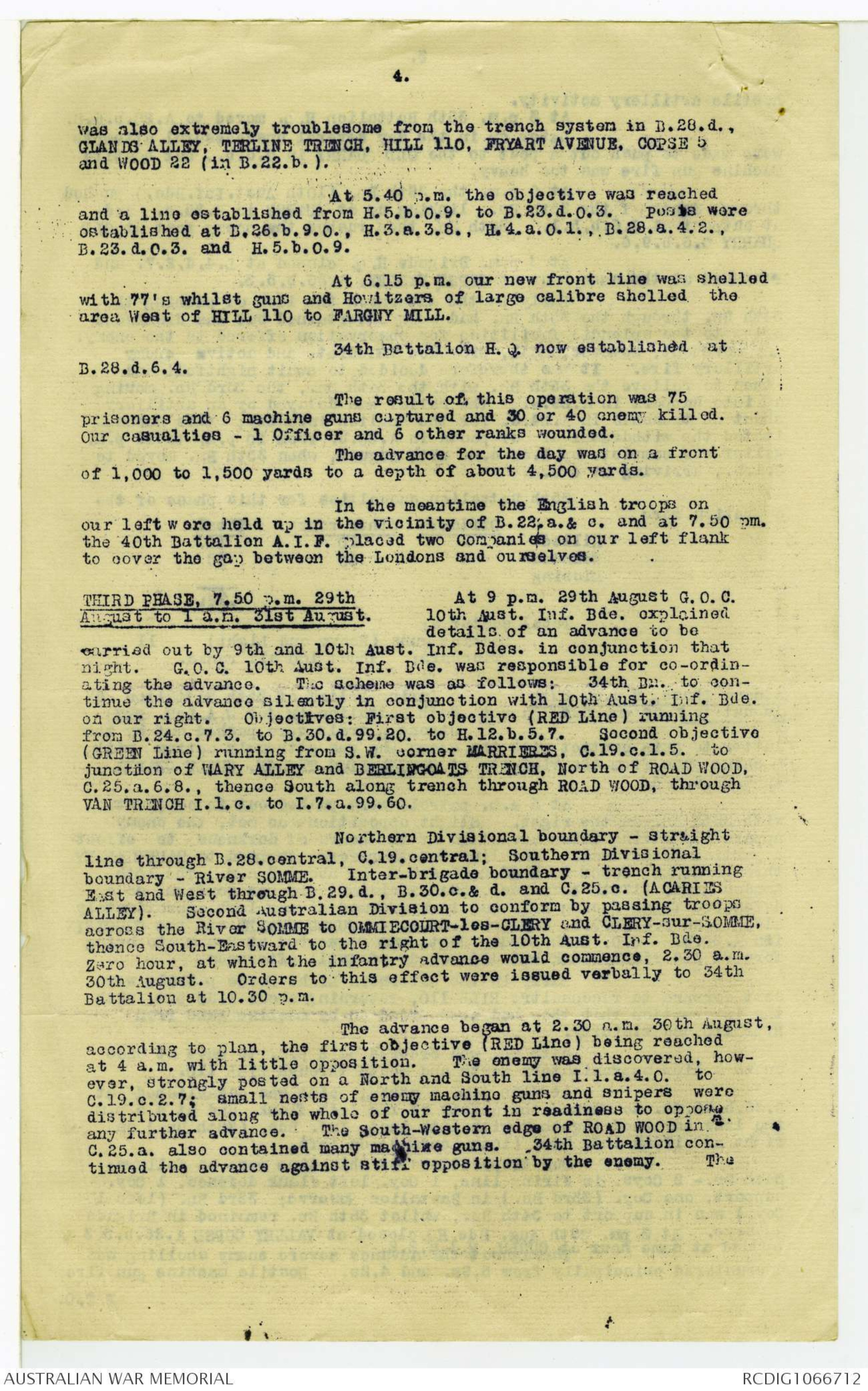
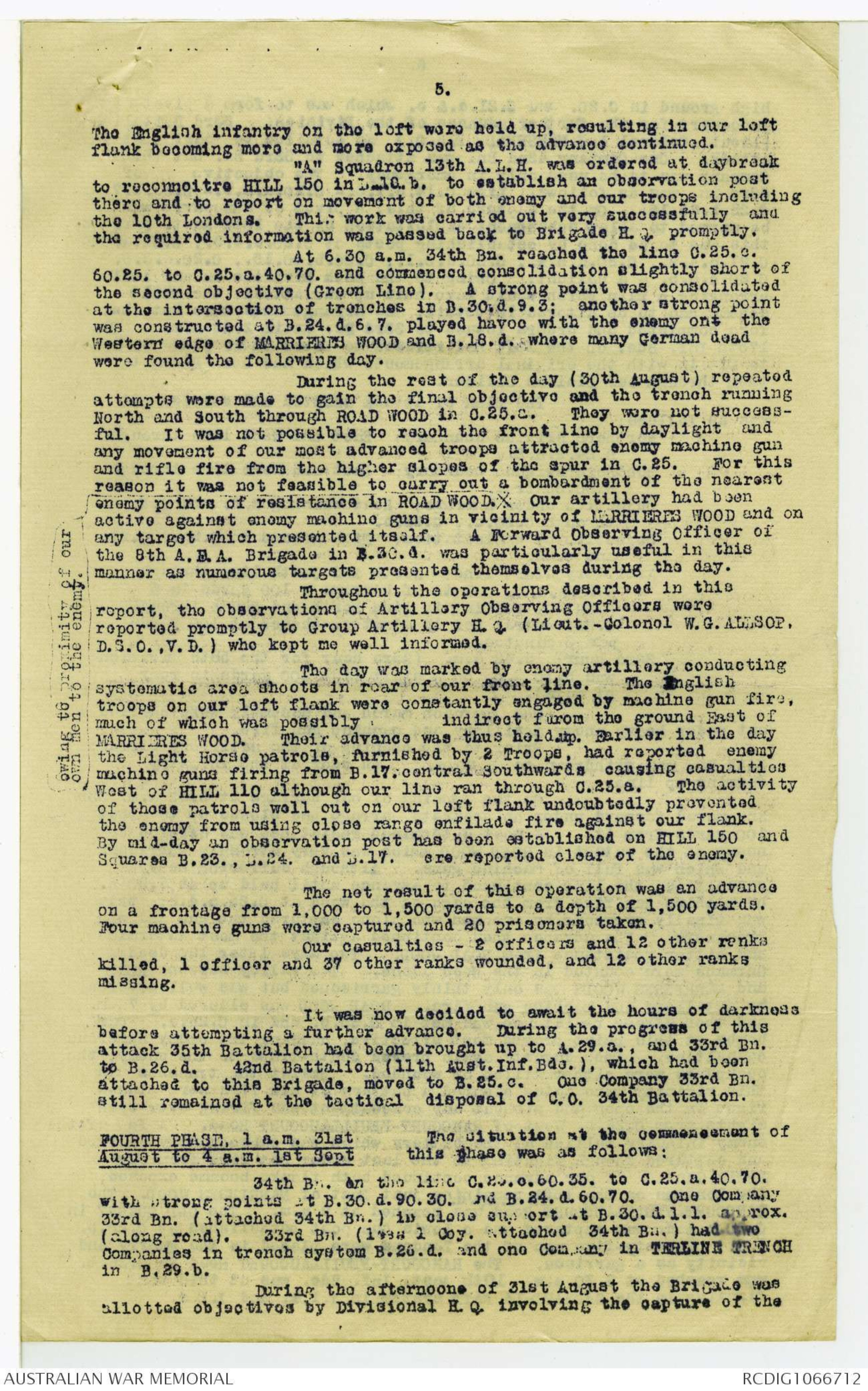
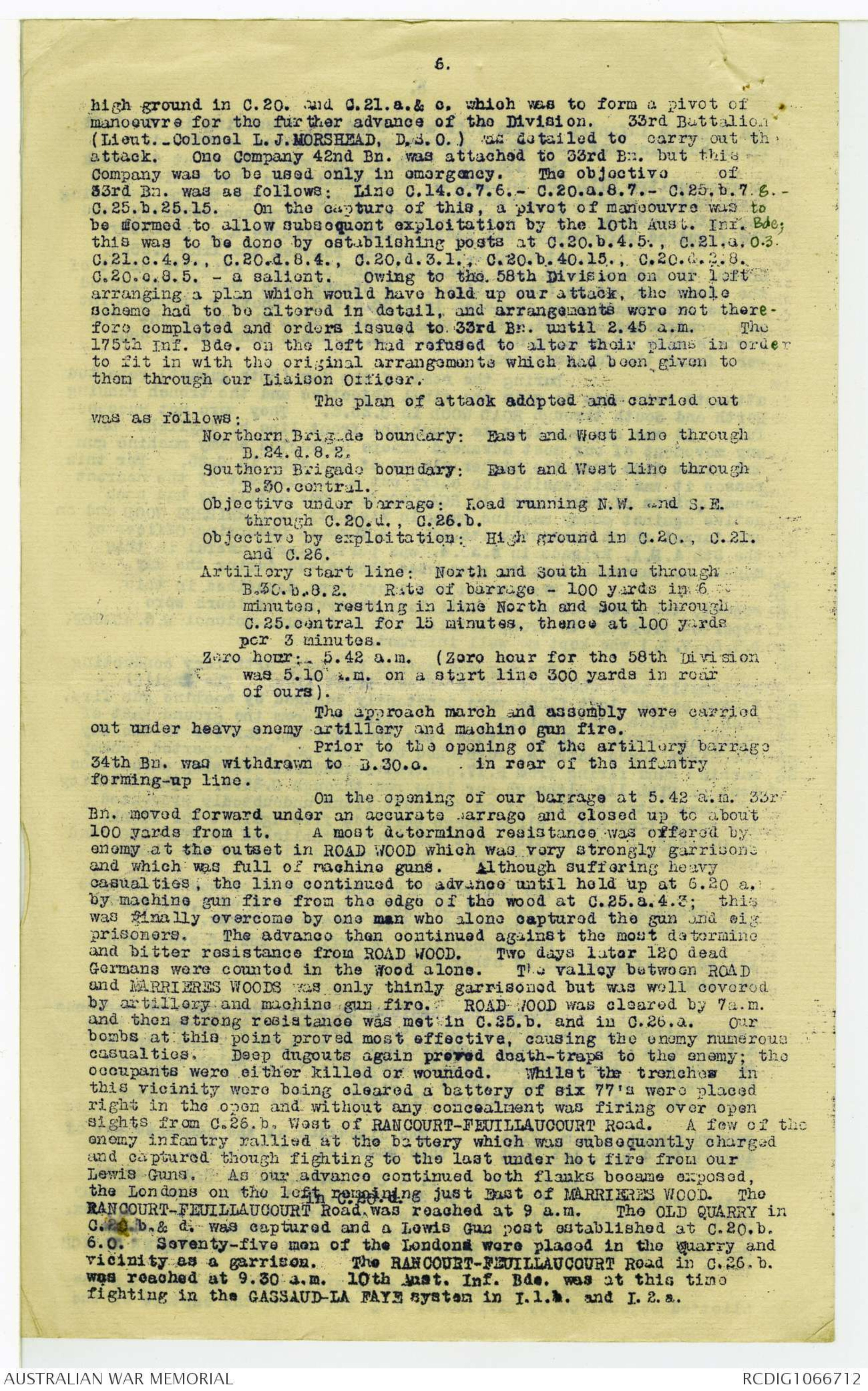
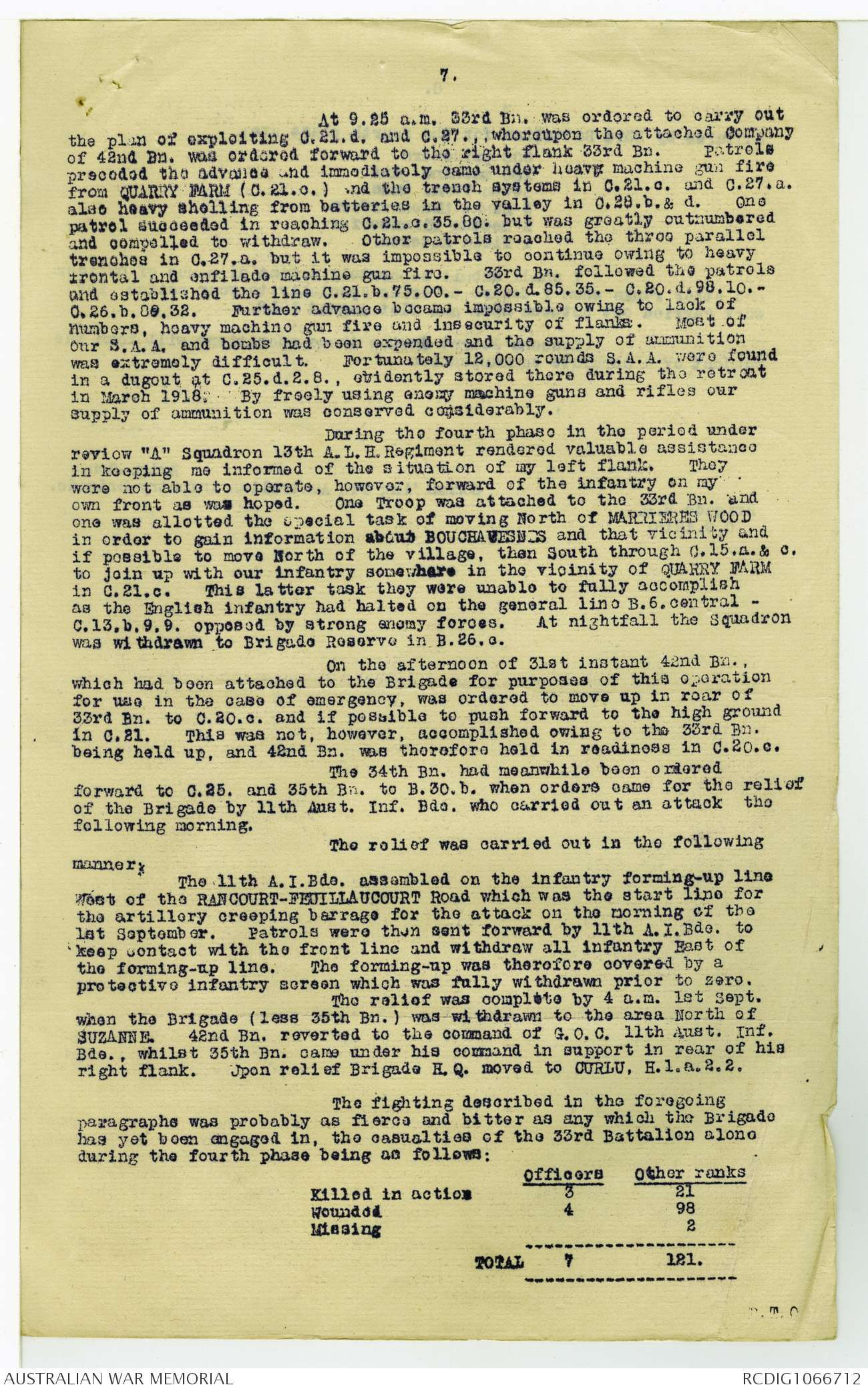
Material for Australian Press.
Gallant Action.
16th Battalion, War Diary.
August 23rd 1918.
[* [[?]] of Record*]
"The Battalion objectives was attained practically
without resistance, but in connecting with the
Battalions on the flanks particularly that on the
left, violent opposition was encountered, the
enemy fighting with machine guns and bombs.
The whole of this fighting dessvolved upon
"D" Company which was commanded by Lieut. L.D.
McCarthy. This officer took one platoon of
about 10 men, and bombed COURTINETRENCH and FOCH
ALLEY - a communication trench leading into
COURTINETRENCH with the intention of connecting
up with the Lancashire Fusilers.
It soon became evident to this party that the
Lancashire Fusilers had not won all the ground alloted
to them. The enemy still had the trench strongly
garrisoned, and he indicated that he intended to put
up a fight. For about two hours the attack in this
quarter see-sawed between victory and defeat, a
particularly violent encounter raged at the junction
of FOCH ALLEY and COURTINETRENCH. Here the Boche
had a strongly occupied position supported by three
machine guns. When close enough to assault this
stronghold, Lieut. McCarthy had only three men
including himself available to carry on the fight.
Accompanied by a runner he rushed over the top and
sought shelter in a shell hole, from where he placed
the three hostile guns out of action in as many minutes.
The first enemy gun was only a few feet away, but its
gunner was shot dead with a revolver without becoming
aware of presence of Lieut. McCarthy.
The second gun was bombed into silence and
the crew of the third despatched by bombs and
revolver shots. By this time Lieut. McCarthy was
working alone, his runner having been wounded. He
continued to make progress along COURTINETRENCH
picking up German bombs as he went, and at S.7.a.7.3. [*?D*]
suddenly came on two German officers and a garrison.
One officer a Company Commander was shot dead and
the second ^shot, placed the second out of action seriously
wounded. Lieut. McCarthy then proceeded to bomb the rest
of the garrison, but directly they learned that their officers
had fallen they "KAMERADED".
The closing episode of this brilliant piece of
single handed fighting which owed its success to the
amazing audacity of Lieut. McCarthy was an amusing one.
The enemy closed in on Lieut. McCarthy from all
sides, wrenched from his hands the bombs with which he was
attacking them, and patted him on the back.
In 20 minutes Lieut. McCarthy had killed 20 Germans
taken 50 prisoners, and had captured a fair proportion of the
Gallant Action.......continued.
trench which was to have been wrested from the enemy
by the Lancashire Fusilers. But for his act it is
more than likely that the Brigade position would have
been seriously menaced if not rendered quite untenable.
The position was handed over to the Lancashire
Fusilers at about noon the same day.
Dear Bean.
I am forwarding to you herewith a report on
operations in connection with which you have not been able to
visit us.
There are many instances which would be of interest
to you which we have perforce been compelled to omit but, which
I am sure would give my General the greatest pleasure in
telling you about.
With kindest regards.
Yours sincerely,
J. H. F. Pain
8th September, 1918.
Mr. C.E.W. BEAN
Official War Correspondent
Australian Imperial Force.
HEADQUARTERS
NINTH INFANTRY BRIGADE
8 SEP. 1918
B.M. NO. 33/259/1
A.I.F.
Headquarters
3rd Australian Division
[*IW= C.E.W. Bean*]
Reference your G.401/1/58 of 2nd instant.
I have to report on operations for 26th to 31st
August 1918 as follows:
FIRST PHASE, 26th August On the 26th August the Brigade was in
to 2.0 a.m. 29th August. Divisional Reserve with Brigade H.Q. in
valley K.32.b.5.2. and Battalions as
follows (vicinity GRESSAIRE WOOD):-
33rd Battalion K.22.
34th Battalion K.17.
35th Battalion K.23.
Units continued to rest and reorganize.
At 6.45 a.m. 27th August the Brigade was ordered
to be prepared to send forward one Battalion to take over the line
from 10th and 11th Aust. Inf. Bdes. that night; the line then ran
from approximately A.29. central, through VAUX, along the Western
bank of the River SOMME to G.23.b. Shortly afterwards confirming
orders were received. Later in the day, owing to the English
(174th Inf. Bds., 58th Division) on our left flank intending to
carry out an attack on the morning of - the 28th instant, the Brigade
was ordered to take over the line ^ from 11th A.I Bde. between the East and West grid
line running through A.22.d.0.0. 35th Battalion took over the front
line: 34th Battalion moved up to support on the line C.4.a.5.2.
(North of VAUK WOOD) to Copse K in A.27.c.3.6., whilst 33rd Bn.
moved to bivouac in C.2. and C.3. At 1.p.m. 27th August Brigade
H.Q. closed at K.32.b.5.2. and reopened at the same hour at
L.4.d.2.7. North of BRAY.
The Brigade was ordered to clear the FAREGNY WOOD
area of the enemy and advance through CURLU to line approximately
North and South through A.30.b. central. The operation was to be
carried out in co-operation with the 8th Londons (174th Inf. Bde.
58th Division) on our left and 10th Aust. Inf. Bde. on our right.
Our plan was as follows:- Northern Brigade
boundary -A.22.d.0.0.- A.23.d.0.0.- A.24.c.0.0.- CURLU CHAPEL to
B. 26,central. Southern Brigade boundary - A.30.c.50.- B.25.d.0.0.
1Oth Aust. Inf. Bde. (38th Bn.) was ordered to co-operate on our
right by moving through CURLU after the village had been cleared of
the enemy, then to prolong the lino of this Brigade to the South as
far as the River SOMME. The artillery start line ran North and
south through A. 29.central. The 35th Battalion (Lieut. Colonel
H. F. WHITE, D.S.O.) was entrusted with the operation. After zero
the 34th Bn. moved up to the position held by the 35th Bn. prior
to zero, and the 33rd Bn. to the position vacated by the 34th Bn.
The objectives chosen wore:
(a) Green Line: Trench system running Northward from the 29.b.9.4.
Eastern end of CHAPEAU de GENDARME to A.29.d.99.50. {{^?]]to A.30.a.
central to A.24.c.2.0. - to be captured under a creeping
artillery barrage.
(b) Red Line: Approximately North and South through A.30.b. cent.-
to be captured by exploitation after capture of Green Line.
Forming-up was complete at 4 a.m., the formation
adopted being 2 Companies in front line, each on a frontage of 2
Platoons: 1 Company in close support in line of Section columns;
and 1 Company in reserve with each of its Platoons in a diamond-
shaped formation (each Section forming a point of the diamond).
At zero hour (4.35 a.m.) our artillery, opened
and remained on the artillery start line for 30 minutes before
commencing to creep Eastward at the rate of 100 yards per 6 minutes
Upon reaching the Green Line, the artillery protective barrage
remained 300 yards East of it per 30 minutes before ceasing.
2.
The advance commenced well, although two company
Commanders wore wounded shortly after our barrage opened. Messages
were received at 35th Battalion H.Q. at 6.10 a.m. and 6.15 a.m.
reporting the capture of the Green Line at 5:50 a.m., in the face of
determined resistance put up by enemy machine gun posts. We suffered
a few casualties through our men being over-eager ^to advance and thus
going into our own artillery barrage. The 8th London Regiment did
not start. However, at 7.50 a.m., at the instigation of Lt.-Col.
White, the C.O. 8th Londons succeeded in moving his men on to the
Green Line. This was reported by 174th. Inf. Bde. on our left at
8.25 a.m.
By this time our patrols had reached the Red Line
by exploitation. The Londons then pushed out patrols which proceeded
only as far as the road running through the CRUCIFIX (A.30.b. 6.8.) to
A.24.d.00. Meanwhile, since zero plus 3 minutes, the enemy had
maintained a heavy area shoot with guns and howitzers of all calibres
over the whole area of advance ^up to and slightly in advance of the Green Line. (Rate of enemy
fire; about 150 rounds per minute scattered over the attacking
Battalion's area).
During the morning (after 8.30 a.m.) our artillery
bombarded SUMMIT COPSE, OBSERVATION WOOD, and QUARRY in H.2.a.&.c.
as being likely enemy centres of resistance, and observation posts.
174th Inf. Bde. concurrently arranged to bombard BATTERY COPSE in
B. 20.a.&. c.
Our artillery barrage, in conformity with the
barrage of the English troops, was far too slow, holding up our
advance, giving the enemy a chance of escaping or organizing to meet
an attack, and allowing his artillery observers to appreciate the
situation. It is realized, however, that our barrage had to conform
to that of the English. The protective barrage was too shallow
allowing the enemy to organize behind it. Consequently, our patrols
met very stubborn resistance from machine gun nests and strong points
which were overcome by the utmost dash and determination. Our left
flank was unfortunately never secure.
At 11.30 a.m. 1 Company 3rd Aust. Pioneer Battalion
was attached to the Brigade for work on the repair of bridges across
the SOMME River in A.29. and G. 4. 5, and.6.
By mid-day dispositions were: 34th and 33rd Bns.
in Support and Reserve respectively: 35thBn in line. with 3 companies
in the outpost (Red) Line, and 1 Company in Reserve in the Green Line.
Posts had been established be the 35th Bn. at the following points:
Outpost line: G 6.b.50.15.
B.25.c.20. 10. A. 30.d.80.30
A.30.d.60.50. A.30.b.50.10
A.30.b.60.50. A.30.b.30.80
Support line A.30.a.55.70
A.30.a.69.35. A.29.b.90.30
A.29.d.70.90. A.29.b.90.70
Six enemy machine guns were used in the consolidation of the support
line.
35th Battalion H.Q. was established at A.28.a.6.5.
R.A.F " " " A.28.a.8.3
Bn. O.P. " " " A.28.a.6.3.
At 2.15 p.m. 174th Inf. Bde. informed me that they
would be relieved by the 175th Inf. Bde. during the night and had no
intention of advancing any further.
During the attack communication was maintained from
Brigade. H.Q. to Battalions by message-carrying rocket, pigeon, runner,
and at 1.10 p.m. by telephone. Visual was tried but without success
0wing to the mist and dust caused by the opposing artilleries. From
Battalion H.Q.. to Companies a visual chain was established to the Green
Line by 6.46am telephone to the Support Company by 7.45 a.m., and to
two of the front line companies at 2p.m. and 5.50p.m. respectively.
The maintenance of telephone lines was particularly difficult owing to
3.
hostile artillery activity.
At 3 p.m. 35th Battalion H. Q. moved to A.28.b.6.8.
Later on in the day several unsuccessful attempts
were made to push out a post to the OLD QUARRY in G.6.b., but hostile
machine gun fire was too heavy.
At 6 p.m. the 38th Bn. (10th Aust. Inf. Bde.) pushed
through South of the 35th Bn., linking up at QUARRY in B.25.c. and
at outpost at G.6.b.5.1. 38th Bn. thon rushed the enemy post at OLD
QUARRY G.6.b.9.6.
At 8.p.m. Brigade H.Q closed at L.4.d.2.7: and
reopened at the same hour at COPSE VALLEY, A.26.b. 5.3.
Early in the afternoon the idea of pushing the
34th Bn. through the 35th Bn. had been entertained but was dismissed
owing to the splendid facilities for observation offered to the enemy.
Any movement, however, small, provoked immediate and active, enemy
artillery fire. It was therefore decided to await nightfall and
then to relieve the 35th Bn. with the 34th Bn., the 33rd Bn. moving
up into support in A.29.a. The relief was delayed by an artillery
shoot on trenches in A.24.d. for the English infantry; this necessitated
the withdrawal of our posts in A.30.b. from 10 p.m. to 11 p.m.
Relief was complete by 1.50 a.m. 29th August, when 35th Bn. moved to
G.1.b., arriving at 4 a.m.
35th Battalion casualties for this phase of the
operation were
Officers Other ranks Total
Killed - 10 10.
Wounded 8 30 38
Missing - - -
48
Total captures:
Machine guns (Heavy and Light) 11
prisoners: About 100 a1l ranks.
Second Phase, 2 a.m. 29th During relief of 35th Battalion by
August to 7.50 pm 25th August 34th Battalion (Major W. A .LeR. FRY)
strong patrols were pushed out by the
latter to gain contact with the enemy who was extremely active with
machine guns from the vicinity of CANTHARIDES TRENCH, CURLU CHAPEL
in B.25.a.& d.
At 5 a.m. patrols were pushed out in conjunction
with 38th Bn. on the right. Slight opposition was met, the enemy
apparently having taken advantage of the hours of darkness to effect
a partial withdrawal. Our line was therefore advanced to SAUVE VALLEY
through SUMMIT COPSE to Road B.25.d.9.3 by about 7 a.m. The 10th
London Regt. (175th Inf. Bde., 58th Division) did not conform, so a
defensive flank facing N.E. had to be formed on our left approximately
along road B.25.d.9.3. through B.25.a. to CURLU CHAPEL and the CRUCIFIX
iin A.30.b. C.0. 10th London Regt, was requested at 8 a.m. to bring
forward his right flank but did not do so until afternoon.
Early in the afternoon Light Horse patrols were
sent forward to reconnoitre HILL 110, returning about 1.30 p.m. with
the information that they had been fired on by machine guns from
HILL 110 and vicinity.
34th Bn. was ordered at 2 p.m. to move at once
on to a line approximately North and South through HILL 110.
At 3.50 p.m. a strong point was established at
B.26.b.95.00. to ensure the safety of the left flank, and at 4.5 p.m.
the line advanced together with 10th Aust. Inf. Bde. (38th Bn.) on
right and 175th Inf. Bde. (10th Londons) on left.
Our dispositions at this time were as follows.
34th bn.- 2 Coys. in firing line, 1 Coy. left flank defence, 1 Coy.
Support, one Coy. (33rd Bn.) in Battalion Reserve; 33rd Bn. (less 1
Coy.; was in support to 34th Bn., whilst 35th Bn. remained in Brigade
Reserve. At 3 pm. 29th Aug. Bde. H.Q closed at VALLEY COPSE A.26.b.5.3 .&-
opened at same hour at CURLU H.1.a.2.2
Throughout the advance severe enemy shelling was
encountered principally from 5.9s. and 4.2s. Hostile machine gun fire
P.T.O.
4.
was also extremely troublesome from the trench system in B.28.d.,
GLANDS ALLEY, TERLINE TRENCH, HILL 110, FRYART AVENUE, COPSE 5
and WOOD 22 (in B.22.b.).
At 5.40 a.m. the objective was reached
and a line established from H.5.b.0.9. to B.23.d.0.3 posts were
established at B.26.b.9.0., H.3.a.3.8., H.4.a.0.1., B.28.a.4.2.
B.23.d.0.3. and H.5.b.0.9.
At 6.15 p.m. our new front line was shelled
with 77's whilst guns and Howitzers of large calibre shelled the
area West of HILL 110 to FARGNY MILL.
34th Battalion H. Q. now established at
B.28.d.6.4.
The result of this operation was 75
prisoners and 6 machine guns captured and 30 or 40 enemy killed.
Our casualties - 1 Officer and 6 other ranks wounded.
The advance for the day was on a front
of 1,000 to 1,500 yards to a depth of about 4,500 yards.
In the meantime the English troops on
our left were held up in the vicinity of B.22.a.& c. and at 7.50 pm.
the 40th Battalion A.I.F. placed two Companies on our left flank
to cover the gap between the Londons and ourselves.
THIRD PHASE, 7.50 P.M. 29th At 9 p.m. 29th August G.O.C.
August to 1 a.m. 31st August. 10th Aust. Inf Bde explain
details of an advance to be
carried out by 9th and 10th Aust. Inf. Bdes. in conjunction that
night. G. 0. C. 10th Aust. Inf. Bde, was responsible for co-ordinating
the advance. The scheme was as follows: 34th Bn. to continue
the advance silently in conjunction with 10th Aust. Inf. Bde.
on our right Objectives: First objective (RED Line) running
from B.24.c.7.3. to B.30.d.99.20. to H.12.b.5.7. Second objective
(GREEN Line) running from S.W. corner MARRIERES, C.19.c.1.5. to
junction of WARY ALLEY and BERLINGOATS TRENCH. North of ROAD WOOD
C.25.a.6.8., thence South along trench through ROAD WOOD, through
VAN TRENCH I.1.c. to I.7.a.99.60.
Northern Divisional boundary - straight
line through B.28.central, C.19. central; Southern Divisional
boundary - RIVER SOMMNE. Inter-brigade boundary - trench running
East and West through B.29.d., B.30.c.& d. and C.25.0. (ACARIES
ALLEY). Second Australian Division to conform by passing troops
across the River SOMME to OMMIECOURT-les-CLERY and CLERY-sur-SOMME,
thence South-Eastward to the right of the 10th Aust. Inf. Bde.
Zero hour, at which the infantry advance would commence, 2.30 a.m.
30th August. Orders to this effect were issued verbally to 34th
Battalion at 10.30 p.m.
The advance began at 2.30 a.m. 30th August
according to plan, the first objective (RED Line) being reached
at 4 a.m. with little opposition. The enemy was discovered, how-
ever, strongly posted on a North and South line I.1.a.4.0. to
C.19.c.2.7; small nests of enemy machine guns and snipers were
distributed along the whole of our front in readiness to oppose
any further advance. The South-Western edge of ROAD WOOD in
C.25.a. also contained many machine guns. 34th Battalion continued the advance against stiff opposition by the enemy. The
5.
Th English infantry on the left were held up, resulting in our left
flank becoming more and more exposed as the advance continued.
"A" Squadron 13th A.L.H. was ordered at daybreak
to reconnoitre HILL 150 in B.18.b. to establish an observation post
there and to report on movement of both enemy and our troops including
the 10th Londons. This work was carried out very successfully and
the required information was passed back to Brigade H.Q promptly.
At 6.30 a.m. 34th Bn. reached the line C.25.c.
60.25. to C.25.a.40.70. and commenced consolidation slightly short of
the second objective (Green Line). A strong point was consolidated
at the intersection of trenches in B.30.d.9.3; another strong point
was constructed at B.24.d.6.7. played havoc with the enemy ont the
Western edge of MARRIERES WOOD, and B. 18.d. where many German dead
were found the following day.
During the rest of the day (30th August) repeated
attempts were made to gain the final objective and the trench running
North and South through ROAD WOOD in C.25.c. They were not successful
It was not possible to reach the front line by daylight and
any movement of our most advanced troops attracted enemy machine gun
and rifle fire from the higher slopes of the spur in C.25. For this
reason it was not feasible to carry out a bombardment of the nearest
enemy points of resistance in ROAD WOOD. X Our artillery had been
[*owing to proximity of our
own men to the enemy.*]
active against enemy machine guns in vicinity of MARRIERES WOOD and on
any target which presented itself. A Forward Observing Officer of
the 8th A.D.A. Brigade in B.30.d. was particularly useful in this
manner as numerous targets presented themselves during the day.
Throughout the operations described in this
report, the observation of Artillery Observing Officers wore
reported promptly to Group Artillery H.Q. (Lieut.-Colonel W.G. ALLSOP,
D.S.O.,V.D.) who kept me well informed.
The day was marked by enemy artillery conducting
systematic area shoots in rear of our front line. The English
troops on our left flank were constantly engaged by machine gun fire,
much of which was possibly indirect from the ground East of
MARRIERES WOOD. Their advance was thus heldup. Earlier in the day
the Light Horse patrols, furnished by 2 Troops, had reported enemy
machine guns firing from B. 17. central Southwards causing casualties
West of HILL 110 although our line ran through C.25.a. The activity
of those patrols wall out on our left flank undoubtedly prevented
the enemy from using close range enfilade fire against our flank.
By mid-day an observation post has boon established on HILL 150 and
Squares B.23., B.24. and B.17. are reported clear of the enemy.
The net result of this operation was an advance
on a frontage from 1,000 to 1,500 yards to a depth of 1,500 yards.
Four machine guns were captured and 20 prisoners taken.
Our casualties - 2 officers and 12 other ranks
killed, 1 officer and 37 other ranks wounded, and 12 other ranks
missing.
It was now decided to await the hours of darkness
before attempting a further advance. During the progress of this
attack 35th Battalion had been brought up to A.29.a., and 33rd Bn.
to B.26.d. 42nd Battalion (11th Aust. Inf. Bde.), which had been
attached to this Brigade, moved to B.25.c One Company 33rd Bn.
still remained at the tactical disposal of C.O. 34th Battalion.
FOURTH PHASE, 1 a.m. 31st The situation at the commencement of
August to 4 a.m. 1st Sept of this phase was as follows:
34th Bn. on the line C.23.c.60.35 to C.25.a.40.70.
with strong points at B.30.d.90.30. and B.24.d.60.70. One Company
33rd Bn. (attached 34th Bn.) in close support at B.30.d.1.1. approx.
(along road). 33rd Bn. (1ess 1 Coy. attached 34h Bn) had two
Companies in trench system B.26.d. and one Company in TERLINE TRENCH
in B.29.b.
During the afternoone of 31st August the Brigade was
allotted objectives by Divisional H.Q. involving the capture of the
6.
high ground in C.20. and C.21.a.& c. which was to form a pivot of
manoeuvre for the further advance of the Division. 33rd Battalion
(Lieut.-Colonel L.J.MORSHEAD, D.S.O.) was detailed to carry out the
attack. One Company 42nd Bn. was attached to 33rd Bn. but this
Company was to be used only in emergency. The objective of
33rd Bn was as follows: Line C.14.c.7.6.- C.20.a.8.7.- C.25.b.7.8
C.25.b.25.15. On the capture of this, a pivot of manoeuvre was to
.be formed to allow subsequent exploitation by the 10th Aust. Inf. Bde;
this was to be done by establishing posts at C.20.b.4.5., C.21.a.0.3.
C.21.c.4.9., C.20.d.8.4., C.20.d.3.1. C.20.b.40.15., C.20.d.2.8.
C.20.c.8.5. - a salient. Owing to the 58th Division on our left
arranging a plan which would have held up our attack, the whole
scheme had to be altered in detail, and arrangements were not there-
fore completed and orders issued to 33rd Br. until 2.45 a.m. The
175th Inf. Bde. on the left had refused to alter their plans in order
to fit in with the original arrangements which had been given to
them through our Liaison Officer.
The plan of attack adopted and carried out
was as follows:
Northern Brigade boundary: East and West line through
B.24. d.8.2.
Southern Brigade boundary: East and West line through
B.30.central.
Objective under barrage: Road running N.W. and S.E.
through C.20.d., C.26.b.
Objective by exploitation: High ground in C.20., C.21.
and C.26.
Artillery start line: North and South line through
B.30.b.8.2. Rate of barrage - 100 yards in 6
minutes, resting in line North and South through
C.25. central for 15 minutes, thence at 100 yards
per 3 minutes.
Zero hour: 5.42 a.m. (Zero hour for the 58th Division
was 5.10 a.m, on a start line 300 yards in rear
of ours).
The approach march and assembly were carried
out under heavy enemy artillery and machine gun fire.
Prior to the opening of the artillery barrage
34th Bn. was withdrawn to B.30.c. in rear of the infantry
forming-up line.
On the opening of our barrage at 5.42 a.m. 33rd
Bn. moved forward under an accurate barrage and closed up to about
100 yards from it. A most determined resistance was offered by
enemy at the outset in ROAD WOOD which was very strongly garrisons
and which was full of machine guns. Although suffering heavy
casualties, the line continued to advance until hold up at 6.20 a.m,
by machine gun fire from the edge of the wood at C.25.a.4.3; this
was finally overcome by one man who alone captured the gun and eight
prisoners. The advance then continued against the most determined
and bitter resistance from ROAD WOOD. Two days later 120 dead
Germans ware counted in the Wood alone. The valley between ROAD
and MARRIERES WOODS was only thinly garrisoned but was well covered
by artillery and machine gun fire. ROAD WOOD was cleared by 7a.m.
and then strong resistance was met in C.25.b. and in C.26.a. Our
bombs at this point proved most effective, causing the enemy numerous
casualties. Deep dugouts again proved death-traps to the enemy; the
occupants were either killed or wounded. Whilst the trenches in
this vicinity were being cleared a battery of six 77's were placed
right in the open and without any concealment was firing over open
sights from C.25.b. West of RANCOURT-FEUILLAUCOURT Road. A few of the
enemy infantry rallied at the battery which was subsequently charged
and captured though fighting to the last under hot fire from our
Lewis Guns. As our advance continued both flanks became exposed,
the Londons on the left remaining just East of MARRIERES WOOD. The
RANCOURT-FEUILLAUCOURT Road ^in C.20.d. was reached at 9 a.m. The OLD QUARRY in
C.20.b & d. was captured and a Lewis Gun post established at C.20.b.
6.0. Seventy-five men of the Londons were placed in the wquarry and
vicinity as a garrison. The RANCOURT-FEUILLAUCOURT Road in C.26.b.
was reached at 9.30 a.m. 10th Aust. Inf. Bde. was at this time
fighting in the GASSAUD-LA FAYE system in I.1.h. and I. 2.a.
7.
At 9.25 a.m. 33rd Bn. was ordered to carry out
the plan of exploiting C.21.d. and C.27., whereupon the attached company
of 42nd Bn. was ordered forward to the right flank 33rd Bn. Patrols
preceded the advance and immediately came under heavy machine gun fire
from QUARRY FARM (C.21.c.) and the trench systems in C.21.c. and C.27.a.
also heavy shelling from batteries in the valley in 0.28.b.& d. One
patrol succeeded in reaching C.21.c.35.80. but was greatly outnumbered
and compelled to withdraw. Other patrols roached the three parallel
trenches in C.27.a. but it was impossible to continue owing to heavy
frontal and enfilade machine gun fire. 33rd Bn. followed the patrols
and established the line C.21.b.75.00.- C.20.d.85.35- C.20.d.98.10.-
C.26.b.80.32. Further advance became impossible owing to lack of
numbers, heavy machine gun fire and insecurity of flanks. Most of
our S.A.A. and bombs had been expended and the supply of ammunition
was extremely difficult. Fortunately 12,000 rounds S.A.A. were found
in a dugout at C.25.d.2.8., evidently stored there during the retreat
in March 1918. By freely using enemy machine guns and rifles our
supply of ammunition was conserved considerably.
During the fourth phase in the period under
review "A" Squadron 13th A.L. H. Regiment rendered valuable assistance
in keeping me informed of the situation of my left flank. They
were not able to operate, however, forward of the infantry on my
own front as was hoped. One Troop was attached to the 33rd Bn. and
one was allotted the special task of moving North of MARRIERES WOOD
in order to gain information about BOUCHAVESNES and that vicinity and
if possible to move North of the village, then South through C.15.a.&.c.
to join up with our infantry somewhaere in the vicinity of QUARRY FARM
in C.21.c. This latter task they were unable to fully accomplish
as the English infantry had halted on the general line B.6.central -
C.13.b.9.9. opposed by strong enemy forces. At nightfall the Squadron
was withdrawn to Brigade Reserve in B.26.c.
On the afternoon of 31st instant 42nd Bn.
which had been attached to the Brigade for purposes of this operation
for use in the case of emergency, was ordered to move up in rear of
33rd Bn. to C.20.c. and if possible to push forward to the high ground
in C.21. This was not, however, accomplished owing to the 33rd Bn.
being held up, and 42nd Bn. was therefore hold in readiness in C.20.c.
The 34th Bn. had meanwhile been ordered
forward to C.25. and 35th Bn. to B.30.b. when orders came for the relief
of the Brigade by 11th Aust. Inf. Bde, who carried out an attack the
following morning.
The relief was carried out in the following
manner;
The 11th A.I. Bde. assembled on the infantry forming-up line
West of the RANCOURT-FEUILLAUCOURT Road which was the start line for
the artillery creeping barrage for the attack on the morning of the
1st September. Patrols were then sent forward by 11th A.I. Bde. to
keep contact with the front line and withdraw all infantry East of
the forming-up line. The forming-up was therefore covered by a
protective infantry screen which was fully withdrawn prior to zero.
The relief was complete by 4 a.m. 1st Sept.
when the Brigade (less 35th Bn.) was withdrawn to the area North of
SUZANNE. 42nd Bn. reverted to the command of G.O.C. 11th Aust. Inf.
Bde., whilst 35th Bn. came under his command in support in rear of his
right flank. Upon relief Brigade H. Q. moved to CURLU, H.1.a.2.2.
The fighting described in the foregoing
paragraphs was probably as fierce and bitter as any which the Brigade
has yet been engaged in, the casualties of the 33rd Battalion alone
during the fourth phase being as follows:
Officers Other ranks
Killed in action 3 21
Wound 4 98
Missing 2
TOTAL 7 121
P.T.O
 Sam scott
Sam scottThis transcription item is now locked to you for editing. To release the lock either Save your changes or Cancel.
This lock will be automatically released after 60 minutes of inactivity.